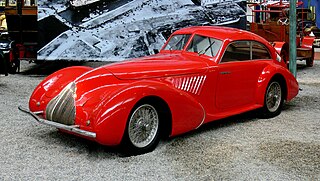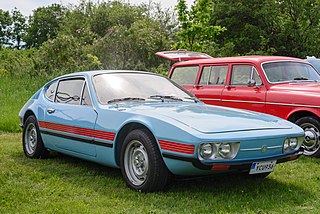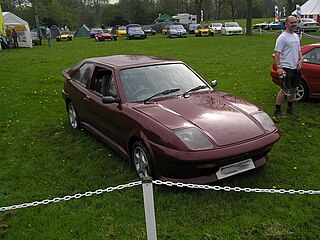
The Alfa Romeo SZ and codenamed ES-30 for Experimental Sportscar 3.0 litre, is a high-performance limited-production sports car built from 1989 to 1991 by a partnership between Centro Stile Zagato, Centro Stile Alfa Romeo and Centro Stile Fiat. It was unveiled as the ES-30 at the 1989 Geneva Motor Show as a prototype by Zagato with the styling house assigned the responsibility of assembling the car.

The Alfa Romeo Alfasud is a small family car manufactured and marketed from 1971 to 1989 by Alfa Romeo as a front-engine, four-door, five-passenger entry-level model over a single generation — with facelifts in 1977 and 1980. There was also a two-door sedan, only available in "ti" trim. Alfa Romeo subsequently introduced a three-door wagon variant, the Giardinetta (1975); two-door coupé, the Alfasud Sprint (1976); three-door hatchback (1981) and finally the five-door hatchback (1982).

The Alfa Romeo 8C was a range of Alfa Romeo road, race and sports cars of the 1930s.

The Alfa Romeo Alfasud Sprint is a boxer-engined coupé produced by the Italian manufacturer Alfa Romeo from 1976 to 1989, and based on the Alfa Romeo Alfasud. 116,552 units of the Alfasud Sprint and Sprint were built in total. The Sprint was sold in Europe, South Africa, Australia, and New Zealand.

The Volkswagen SP2 is a sports car that was developed by Volkswagen do Brasil and built from July 1972 until December 1975. It is based on the chassis of the Brazilian market Volkswagen Type 3. "SP" is said to be an initialism of São Paulo, where the car was built, or of "sports prototype". In its issue of 20 June 1973, German technology magazine Hobby called the SP2 the "most beautiful Volkswagen in the world".

The Alfa Romeo 33 Stradale is a mid-engine sports car built by Italian automobile manufacturer Alfa Romeo. It was the fastest commercially available car for the standing kilometer upon its introduction. 18 examples were produced between 1967 and 1969. "Stradale" is a term often used by Italian car manufacturers to indicate a street-legal version of a racing car; indeed the 33 Stradale was derived from the Tipo 33 sports prototype. Built in an attempt by Alfa Romeo to make some of its racing technology available to the public, it was also the most expensive automobile for sale to the public in 1968 at US$17,000.
The Delfino Feroce is an unproduced British sports car manufactured by Delfino. The prototype was built using the Subaru Impreza power unit and mechanical parts with a Delfino monocoque chassis designed by Andy Borrowman and Sean Prendergast. The prototype along with the moulds was purchased by Allard Marx who then founded Delfino cars. It was powered by a turbocharged flat-4 Subaru engine. It is capable of a 0-60 mph time of under four seconds.
Peter John Pellandine was a British car designer and manufacturer who was influential in the field of specials/kit cars and steam-powered vehicles in both the United Kingdom and Australia.
Pellandini Cars was a manufacturer of kit cars during the early 1970s that was located in South Australia.

The GTM Coupé is a Mini based kit car dating back to 1967. GTM is an initialism for "Grand Touring Mini". The car was first shown at the 1967 Racing Car Show and soon afterwards went into production by the Cox brothers from their garage in Hazel Grove, Stockport as the Cox GTM. In 1969 the rights to the design and manufacturing were bought by Howard Heerey and the Cox part of the name was dropped. Heerey's father's company, Midland Garage, took over manufacture of the GTM. In April 1980 ownership changed again to GTM Engineering, who upgraded and continued to manufacture the Coupé until 1995.

The Alfa Romeo 8C Competizione is a sports car produced by Italian marque Alfa Romeo between 2007 and 2010. It was first presented as a concept car at the 2003 Frankfurt Motor Show. The name refers to the eight-cylinder engine (8C) and Alfa Romeo's racing pedigree. The company received over 1,400 orders for the 8C after the official announcement that the car would enter production. However, only 500 customers ended up with the 8C Competizione and another 329 with the 8C Spider, bringing the production total to 829 cars.
Fiberfab was an American automotive manufacturer established in 1964. Starting with accessories and body parts, they progressed to making kit cars and fully assembled automobiles. They became one of the longest lasting kit car manufacturers.

Quantum Sports Cars was founded by Mark and Harvey Wooldridge in 1987.

Eagle Cars Limited was an English company, based in Lancing, West Sussex, originally operated by Allen Breeze, although it has undergone a number of ownership changes since. Originally making a Jeep lookalike called the RV, between 1981 and 1998 they built several iterations of a gull-winged car called the Eagle SS. The SS was based on an American kit car called the Cimbria, and was brought to the UK by Tim Dutton. In 1988 Eagle Cars moved inland, to nearby Storrington.
Mills Extreme Vehicles (MEV) is a kit car design and manufacturing company based in Gloucestershire, England, founded in 2003 by Stuart Mills and Julie Wilson.

The Alfa Romeo Caimano is a concept car designed by Giorgetto Giugiaro of Italdesign and presented at the Turin Motor Show in 1971. The car is exhibited at the Museo Storico Alfa Romeo.
Minari Engineering Ltd. was a Limited company based in Staffordshire, UK. They manufactured two vehicles, the Minari Club Sport, and the Minari Road Sport. They specialised in producing the components required to build cars based upon the Alfa Romeo Alfasud and 33 running gear, with bodies mainly constructed from GRP. These could either be purchased in Kit form or through a build agent, Chameleon Cars. Around 130 Mk2 kits were sold before production finally stopped in 2000.

The Alfa Romeo Tipo 103 is a sub-compact front-wheel drive automobile developed by Alfa Romeo in the late 1950s. A prototype powered by a 0.9 L double overhead cam inline-four engine was completed in 1960. Alfa did not put the Tipo 103 into production.

New Zealand had a long history of small garages and vehicle enthusiasts modifying and creating sports and sports racing cars. Out of these interests grew the New Zealand kit and replica car industry with the introduction of fibre-glass car bodies in the 1950s.
The BS Nymph was a fibreglass monocoque British buggy based on running gear from the Hillman Imp, including its rear-mounted 875 cc engine. While meant by Chrysler UK to enter series production to the tune of 4000 cars per annum, the Chrysler corporation discontinued the Imp before the Nymph was released. Rather than competing globally with the Mini Moke as intended, the Nymph entered small-scale production as a kit car and only 42 cars were finished. The designers, Peter Bohanna and Robin Stables, are perhaps best known for having designed the "Diablo GT", which later was developed into the AC 3000ME.













